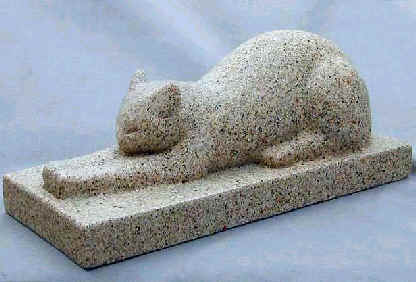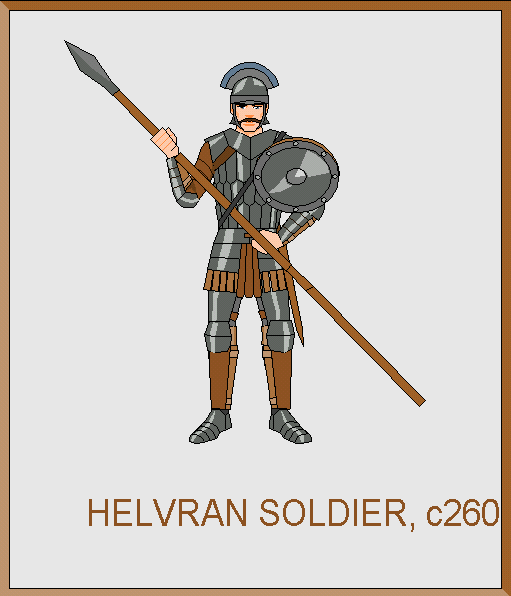|
Home Page
Discovery of Atlantis
First Empire-(1) to 261
Second Empire- (1) 361 - 409 |
|
ATLAN CER¤EH I : CER¤EH ENUL
THE FIRST EMPIRE 199 - 361
1: The Founding of the Atlantean State : Lir-Craonos and Carel I, 199-249. : Lir-Craonos, 199-214.It was in 166 that the Atlantis finally succeeded in unifying various small states, each run by the local nobles. The resulting large state became a kingdom, but in the 190's it was plunged into civil war as some of the nobles sought to overthrow the king and regain their ancient rights. The noble who won the war and inherited the whole kingdom was Lir-Craonos. Within months of his succession Lir-Craonos, hitherto just a king (or "Duicco") declared Atlantis an Empire, and himself the first Emperor (" Cerex"). It is from this moment that the First Atlantean Empire, and indeed the whole history of Atlantis was generally reckoned to date. Before this time, indeed, we have no true history of Atlantis, but from now on an increasingly bright historical light illumines the tale of Emperors and people. Lir-Craonos, though an important person and later revered as the founder of the Atlantean Empire, is known really only through doubtful stories, myths and legends. His achievements are debatable but certainly they concerned establishing stability after the earlier years of turmoil. During his reign he set about eliminating all potential rivals, and executed or banished all those who had not already been killed in the civil wars. All remaining important nobles were banished to their estates, and only about twelve were allowed to retain their traditional but much abused right of maintaining private armies - and then no larger than 5000 men at most. Lir-Craonos reduced quite considerably the authority of the great land-owning nobility and fostered lower-class nobles or townspeople to run local government. Lir-Craonos spread his relations over all areas of the Empire, and was able to maintain his rule by relying on their support. He also appropriated a great deal of land for the crown, and by 214 Lir-Craonos was much the greatest land-owner of the Empire. We have records of a couple of revolts by individual aristocrats, but these came to romantic but disastrous conclusions. As a person, Lir-Craonos was evidently a large and imposing man, given to sudden outbursts of anger. He could be cruel and forgiving by turns, and his character is generally agreed to have been devious and unfathomable and certainly never predictable. He died in 214 as a result of a horse-riding accident, and the succession passed smoothly and according to his wishes to his nephew Carel I, then aged 29.
The Creator of the Atlantean State : Carel I, 214-249 THE GREATEST OF THE EARLY EMPERORS Carel I was always regarded by later Atlantean historians as the great founding-father of the Atlantean state, and the noblest of the Emperors of the First Empire. It was he who established the great liberal tradition in government, politics, law and the arts, which runs like a thread through all later Atlantean history, and was emulated especially by the great Second Empire emperors from Atlaniphon I onwards. Certainly Carel's character was very different from that of his uncle. He was of medium height, with sensitive features, great intelligence, and a tremendous intellectual curiosity in all fields - law, politics, geography, languages, religion, philosophy and the arts. He surrounded himself with able executives and also with an amazing variety of scholars, priests, foreigners, travellers and artists. He treated everyone as an equal with regard to their own brains and skills, and often shocked his conservative courtiers by his philosophical interests, religious speculation, political changes, and liberalisation of the law. HIS ACHIEVEMENTS His reforms were many and varied. In religion, he gradually reduced the great power of the priesthood. This was particularly true in the realms of moral law (adultery, theft, violence, blasphemy, etc.), where he eased many cases out of the prerogative of the priesthood and into civil law-courts. This was largely due to the influence of the philosopher-lawyers who surrounded him at court. These men included Liclencu, the first known non-religious philosopher, and Thulpas, the great legalist, who flourished in the 220's and 230's. They were seeking to understand how social life could be regulated by law rather than by religious precept. Carel always evinced intense interest in liberal religion, and was fascinated by the details of religious heresies, new faiths, such as Naturism (Natural Religion) which emerged in Helvr´eh in the 230's, and astrology. Law was the nub of Carel's social reforms. In 221 he abolished human sacrifice in religious ceremonies, and in 224 set up courts of justice (the Royal Courts) throughout the country. In 223 he made all citizens, including himself, equal before the law (in principle), and abolished slavery. He also set up a regular system of local government, based on a number of large towns, and placed the organisation of taxation in the hands of newly founded counties. The first parliament, of sorts, was created in 246 when the Great Council for Atlantis was set up, initially purely as an advisory body. He also began the building of a great Imperial Palace in the northern part of Atlantis city, and improved the capitalĺs harbour facilities. In foreign affairs Carel was chiefly concerned to spread his ideas on social welfare and progress and the rule of law to the Atlanteans of the Atlantid City States. This was achieved peacefully in the 230's and 240's, and many City States formed close alliances with Atlantis. In 244 some were united in a separate Province (Atlantid´eh) with an Atlantean Governor. These states happily accepted the civil benefits of union, which included full citizenship rights in the western states after 248, but the county taxation system led to some opposition. WARS OF THE REIGN The only real war of the reign was the First Phonerian War of 241-245. This was due largely to Phonerian raiding Atlantean territory, and Carel really only wished to teach the Phonerians a lesson - he was one of the least imperialistic of all First Empire Emperors. The Phonerians, who, like all the Lio-Marossan states, were a sea-faring and trading republic, and at this point were led by a man called Eiruton Ouphote, The war was hardly successful for the Atlanteans, and ended with only minor territorial gains in NW. Atlantid´eh, and the agreement by both sides for specific limits on trade and travel. Further conflict potential developed in the later 240's with the Helvran Empire, as Atlantis tried to "reclaim" Atlanteans in the south Atlantid City States, the Rundes area, and the River Fellepp border, all of which were seen by the Helvrans as part of their empire, or at least as subservient satellites or independent buffer states. "Illegal" trade with the Coastal City States of the Helvran Empire by Atlantean merchants also caused tension, and diplomatic exchanges in 247-8 were becoming increasingly fraught. Then in 248, very suddenly, Carel I fell gravely ill, and within three days he was dead.
An example of the smallscale modelled art of around 240
2. Crehei Ante Helvranix ("The War with the Helvrans"), Vulgenel Greux ("The War of the Heroes"), 250-267.THE SCANTY EVIDENCE OF THE EMPEROR'S PERSONALITY Carel I's designated successor was his son, Carel II, who was 39 years old in 249. His short reign was dominated by the war against Helvris, and a disastrous series of defeats leading to the death of the Emperor himself. As a person, we have little information about Carel. He was evidently not gifted militarily and left fighting to his generals until his first and last appearance on a battlefield at Cennis in 252. He seems to have been dominated by his younger brother, who fought in the war, was made his heir, but was also killed at the battle of Cennis. Carel is said to have had some artistic pretensions, and later writers also embroidered tales around his love-life. One girl - friend died in 249, and in 251 he fell in love again, but never married as he was killed next year at Cennis. Such is the threadbare narrative of Carel's private life; but in any case everything was dominated by foreign affairs. The quarrels between Atlantis and Helvris, mentioned above, came to a head in 250. War was largely due to the Helvran Emperor's refusal to put up with an overbearing neighbour on his northern border. Carel, though somewhat colourless as a person, was stubborn over his refusal to give way on Helvris's demands, and he was backed by a warlike clique at court. In fact the outcome of any major war between the two empires seemed certain to be victory to the Helvrans. They had a huge empire all around the Helveng´o of ten million people, and an army of 70000 in peacetime and 120000 in war. This army was a veteran and well-trained force, whose main tactical weapon was its use of phalanxes of bristling pikes. To oppose this force, the Atlanteans had in peacetime virtually no army, although a sizeable force could and was raised in wartime. Things were initially very ad hoc, and it is clear that Atlantis at first only expected a few small-scale fights, to trounce the Helvrans, and then a satisfactory peace-treaty. When it became clear that the war was going to be longer, harder and far more dangerous than had ever been expected, Atlantis finally put all her powers to raising a strong, disciplined and well-generalled army. By 260 this was 135000 strong. At sea, too, the Helvrans had an unsurpassed navy of some 300 oared ships in the Helveng´o, based at Giezuat and elsewhere. The Atlanteans had only some 75 ships on 248, but again by dint of furious efforts this total was increased to over 200 by 255. Helvron girteks ed zair. "Kengirn atlan meu derkel (The Helvran king and people). We shall fight the Atlanteans with our ships,
THE HELVRAN WAR (This is a summary version: a detailed history is given here: The Helvran War ) War began late in 250 after a series of small skirmishes. To the Atlanteans, this great conflict would be simply the "War with the Helvans" ("Crehei ante Helvranix"), but the Helvrans afterwards named it the "War of the Heroes" ("Vulgenel Greux" in Helvran). An Atlantean army invaded (Helvran) Numidis in 251, but was beaten back, while a Helvran force took Rundes. The Helvrans now prepared an army of 30000 men in Numidis which invaded Atlantis in 252. After one defeat near the River Fellepp, Carel himself joined the army. There followed the in August the Battle of Cennis. This proved to be a crushing defeat for the Atlanteans, and its army lost 10000 men, including the Emperor himself. Fortunately the Helvrans made no attempt to advance on to the capital, although its navy did move up to institute a brief blockade.
THE EMPEROR We know little about Carel as a person, other than that he was very dark, tall, with piercing blue eyes, but not very robust in health. He was very young - only 19- when he came to the throne, and 27 when he died. He never married and seems to have made no attempt to provide for an heir in the case of his own death : this would lead to trouble when he did die unexpectedly. Carel found time to carry out a lot of building work within the Atlantis city during his reign. These included a new temple, as well as improvements to the harbour defences of the port. He also created a considerable military base on the island ("Atlano Mandeng´o") across the narrow channel from the city of Atlantis. This island had hitherto been inhabited by a religious community, with a number of holy sites and temples. It also had a small port for the Atlantean navy, opposite Atlantis city itself. The war with Helvris gave the island a vital strategic role to Atlantis, and henceforth it would always contain a military garrison, and also developed into the main naval base for the Empire named "Mandengatlan." The war with Helvris dominated Carel III's reign, and Carel himself, a more able administrator than his uncle, managed gradually to find more capable generals and ministers to run the war. One of these was Cao-Mel´on, Carel III's cousin, who was only 24 in 253 but already a gifted war-leader. He would later become Carel's successor. From 253 general military training and some conscription was introduced, and by 258 the first long-serving, professional and paid army was in being.
THE HELVRANS' EARLY SUCCESSES The war with Helvris see-sawed to and fro for the first years of Carel's reign. After their victory at Cennis, the Helvran army leisurely advanced on Atlantis itself, but the Atlanteans had managed to concentrate an army of 22000 men on the Algrunix to defend the capital. The Helvrans attacked with 30000 men but were unable to storm the strong Atlantean defences. (First battle of the Algrunix). They then retired back south across the river Fellepp. Atlantis tried unsuccessfully in 254 to get Helvris to agree to a peace-treaty, but the war went on, now with an Atlantean army taking Lillouth and advancing to besiege Ugholtis (as it would later be named). This siege became a set-piece in 255, but was later broken by a Helvran relief army forcing the Atlanteans back to Lillouth. To the east, Helvran forces occupied the whole of S.W.Atlantid´eh. In 256 the Helvrans again forced the Atlanteans back from Lillouth. Now Carel III personally took command , united two armies to a total of 41000 men and held the Helvrans to a draw when they attacked at the Battle of Yeldis. At the same time, in the east, the Atlanteans retook Gentes after a siege. This can be said to end the first part of the war. The Helvrans would never again make incursions into Atlantean territory, and Atlantis now took the initiative in a second phase which lasted till 261. ATLANTIS TAKES THE INITIATIVE Over the next four years, the Atlanteans gradually reconquered south Atlantid´eh. In the centre around Lillouth there was something of a stalemate, and not until 260 was Lillouth retaken by the Atlanteans. At sea, however, the Atlanteans gained the upper hand by defeating a Helvran fleet off the Cressix Mandengix islands, which now became a permanent Atlantean naval base. With their command of the sea now assured, the Atlanteans landed an expeditionary force of 18000 men in Numidis in 258. The following year, after their forces in Numidis had been increased to 45000, 25000 of them were moved amphibiously to Miolrel on the south of the Helveng´o in the W.City States. This led in 260 to the rebellion of many of these cities, and their espousal of the Atlantean cause. Rebellions, too, broke out in Manralia, which was a partially independent kingdom in the Helvran Empire, with its own religion and religious hierarchy, which went right back to the South Numedeans. It seems that by 259 and 260 the Atlanteans had groped towards their strategy for ultimately defeating Helvris. They clearly planned to foment or encourage rebellions in Helvris' southern provinces by landing Atlantean forces there, and then, gaining naval command of the Helveng´o, strike right to the heart of the Helvran Empire at Giezuat and Helvris themselves. THE CAPTURE AND DEATH OF THE EMPEROR However there now, in 260-1, occurred some major defeats which imperilled the whole of this strategy. In 260 the Helvrans defeated the Atlanteans in a sortie from their naval base at Giezuat in the First Naval Battle of Giezuat. Then in 261, as an Atlantean army of 40000 men advanced from Numidis on Cennetis across the River Numeras, it was taken by surprise half-way across and defeated with the loss of 19000 men. Most serious of all, Carel III, who was leading this force, was injured and captured. This was in September. Carel was subsequently badly treated by his captors and died in December. To read the next part of this history, click on (2) 261-307
THE HELVRAN WARS, 250 - 267 |



